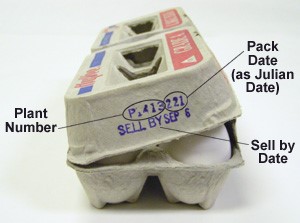Filter By

Understanding Dates on Egg Cartons
Many eggs reach stores only a few days after being laid. Determining the freshness of eggs can be confusing at times, as some egg cartons feature two dates. 
The Julian date is the “pack date,” when the eggs were washed, graded and place in the carton. This three-digit code represents the consecutive day of the year, with January 1 as 001 and December 31 being 365. The Julian date is usually found on the short side of the carton. E ggs are safe to be consumed four to five weeks beyond that date, as long as they are kept refrigerated.
Many egg cartons also have a sell-by date or expiration date. These dates are not required by the federal government but may be required by state laws where the eggs are marketed. Always purchase eggs before the sell-by or expiration date on the carton. On cartons with the USDA grade logo, the expiration date cannot exceed 30 days after the eggs were packed in the carton. Eggs packed in cartons without the USDA grade logo are governed by the laws of their states.
In addition to the dates, you should also check your eggs for cracks, purchase eggs that include the USDA grade mark, and buy eggs from a refrigerated case. Choose the most economical and useful egg size for your lifestyle.
For other tips and news on egg safety, check out our blog archives, follow us on Twitter or Facebook.

 Back
Back